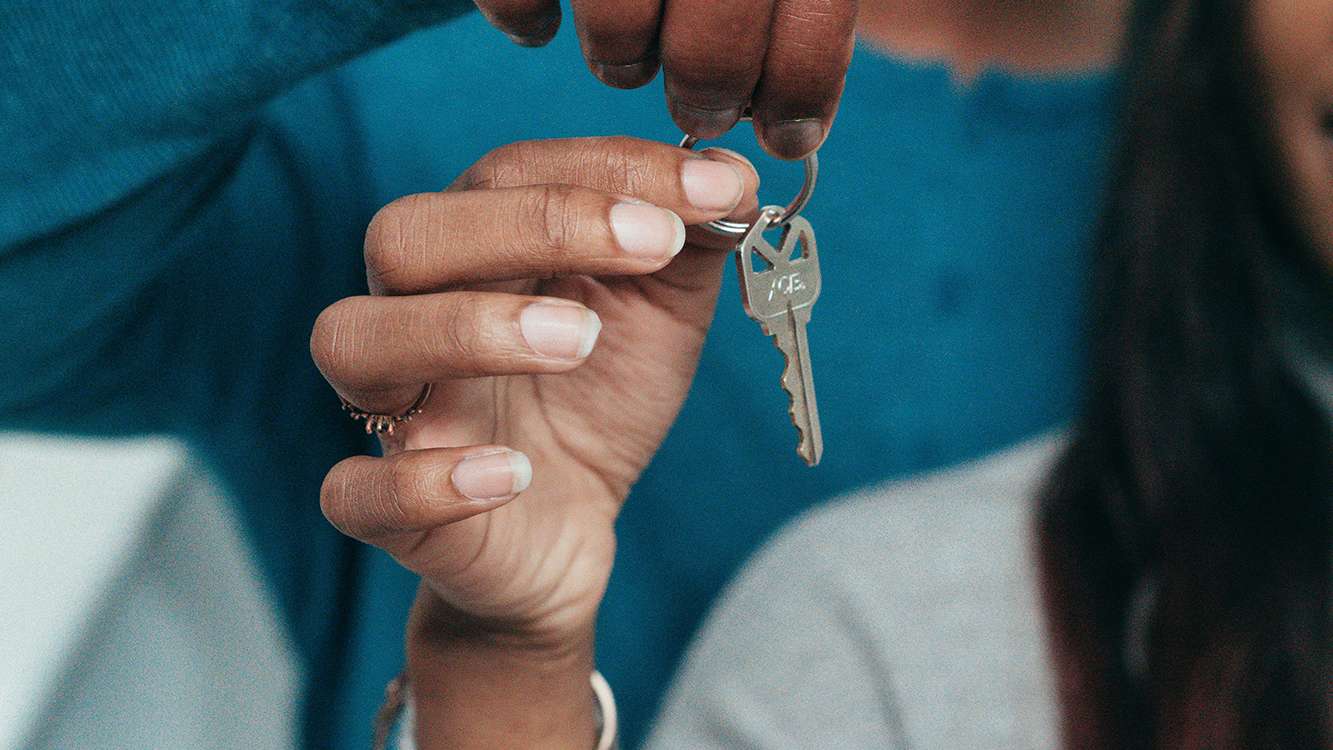
The moment when someone receives their first set of house keys represents far more than a simple transaction; it symbolizes the realization of the American Dream, financial security, and the achievement of a major life milestone. Yet for many Americans today, the path from aspiring homeowner to holding those coveted keys has become increasingly challenging.
Current statistics reveal both the persistent appeal of homeownership and the growing barriers that stand between dreams and reality. This is why we’re launching our Keys and Dreams campaign. We want to show why homeownership still matters to everyday Americans today.
The Current State of American Homeownership
The landscape of American homeownership presents a complex picture of achievement and aspiration. The homeownership rate in the third quarter of 2024 was 65.6%, down 3.6 percentage points from 2004’s homeownership peak. This decline from historical highs reflects the challenges facing today’s potential buyers, even as the majority of Americans continue to achieve their homeownership dreams.
Federal Reserve data provides additional context about who holds the keys to homeownership success. Sixty-three percent of adults owned their homes, while 28 percent rented. Homeownership rates varied substantially by income. Thirty-five percent of adults with less than $50,000 in income owned their home, compared with 85 percent of adults with a family income of $100,000 or more. These statistics underscore how financial resources directly impact the ability to transform homeownership dreams into reality.
The Growing Challenge for First-Time Buyers
Perhaps nowhere is the tension between dreams and reality more evident than among first-time homebuyers. Recent data reveals a concerning trend: The first-time homebuyer market share decreased to a historic low of 24% (down from 32% last year), while home buyers’ ages hit all-time highs of 56 years overall (49 last year), 38 years for first-time buyers (35 last year), and 61 years for repeat buyers.
The implications of these statistics are profound. First-time buyers, who traditionally drive housing market activity and represent new entrants into homeownership, are being squeezed out at unprecedented rates. The increase in average buyer age suggests that people are waiting longer to purchase their first homes, delaying a key milestone in financial independence and wealth building.
Aspiring Homeowners Face Mounting Pessimism
The psychological impact of these market conditions becomes clear when examining the attitudes of aspiring homeowners. Seventy percent of aspiring homeowners are concerned they will never be able to own a home, and 62% believe the housing market is rigged against first-time homebuyers. These statistics reveal how market conditions are not just creating financial barriers but also psychological ones, with potential buyers losing hope that their homeownership dreams are achievable.
This pessimism represents a fundamental shift in how Americans view the path to homeownership. What was once seen as an attainable goal with sufficient planning and saving is now viewed by many as an insurmountable challenge, fundamentally altering the traditional narrative of the American Dream.
The Time and Money Equation
The practical challenges behind these statistics become evident when examining the financial requirements for homeownership. The average homebuyer would need approximately 8.7 years to save for a competitive down payment, according to data from November 2023. This timeline represents a significant commitment that many potential buyers find daunting, especially when competing priorities like student loans, rising rents, and the general cost of living consume available savings.
The income requirements for homeownership further illustrate the challenge. That is based on a $72,950 down payment, a $291,800 loan, and monthly expenses not exceeding the 28 percent barrier, meaning wage earners would not be spending more than 28 percent of their pay on mortgage payments, property taxes, and insurance. These figures demonstrate the substantial financial resources required to responsibly purchase a home while maintaining other financial obligations.
Generational Perspectives on Homeownership Dreams
Different generations approach homeownership with varying levels of optimism and different timelines for achievement. 71% of younger millennials and 36% of older millennials were first-time home buyers. 66% of older millennials were married couples, while younger millennials had the highest share of unmarried couples (13%) buying homes.
These statistics reveal how life circumstances and timing influence the path to homeownership. Younger millennials, despite facing affordability challenges, maintain higher rates of first-time buying, suggesting resilience in pursuing homeownership dreams despite obstacles. The data also shows how relationship status and life stage affect both the desire and ability to purchase homes.
Market Persistence Despite Challenges
Despite the obstacles, Americans continue to pursue homeownership goals with remarkable persistence. Despite the challenges homebuyers may face, 13% of Americans plan to buy a new home in 2024. Among current homeowners, 46% plan to sell their current home, while 54% intend to keep their current home as an investment.
This ongoing market participation demonstrates that while the path to homeownership has become more difficult, the fundamental desire to own a home remains strong. The statistic also reveals how current homeowners are thinking strategically about their real estate holdings, with many viewing their homes as investment vehicles rather than just places to live.
The Support Infrastructure Grows
Recognizing the challenges facing aspiring homeowners, support programs have expanded significantly. The Q1 2025 Homeownership Program Index reveals 43 programs were added last quarter for a total of 2,509 – the highest number of programs DPR has recorded. This proliferation of assistance programs reflects both the acknowledged need for support and the commitment of various organizations to help people achieve their homeownership dreams.
These programs represent hope for many aspiring homeowners who might otherwise conclude that homeownership is beyond their reach. From down payment assistance to favorable loan terms, these initiatives help bridge the gap between dreams and financial reality.
Affordability Remains a Critical Challenge
The fundamental challenge facing aspiring homeowners is affordability. Compared to historical levels, median home ownership costs in 554 of the 574 counties analyzed in the first quarter of 2025 are less affordable than in the past. This widespread affordability crisis affects markets across the country, making homeownership dreams more difficult to achieve regardless of location.
The scope of the affordability challenge suggests that solutions must address both supply and demand factors in the housing market. For individual aspiring homeowners, this reality means longer saving periods, creative financing solutions, or geographic compromises to achieve their homeownership goals.
The Psychology of Keys and Dreams
The symbolism of receiving house keys extends far beyond the physical act of unlocking a door. For most Americans, those keys represent financial stability, the ability to build equity, creative control over their living space, and achievement of a culturally significant milestone. The weight of these symbolic meanings helps explain why homeownership aspirations persist despite mounting challenges.
The dream of homeownership connects to fundamental human needs for security, stability, and belonging. When market conditions make these dreams seem unattainable, the psychological impact extends beyond disappointment to affect how people view their financial prospects and place in American society.
Strategies for Turning Dreams into Reality
Despite the challenges revealed in current statistics, aspiring homeowners are finding ways to achieve their goals. Success often requires adjusting expectations, extending timelines, and exploring alternative paths to homeownership. This might include considering different geographic areas, exploring various loan programs, or finding creative ways to accelerate savings.
The increase in homeownership assistance programs provides more tools for aspiring buyers to bridge financial gaps. Understanding and accessing these resources can make the difference between continued aspiration and actual key possession.
Looking Forward: Hope Amid Challenges
While current statistics paint a challenging picture for aspiring homeowners, they also reveal the resilience of the American dream of homeownership. People continue to pursue these goals, programs continue to expand to support them, and market conditions, while difficult, continue to enable homeownership for those who persist.
The journey from dreams to keys may take longer and require more creativity than in previous generations, but the fundamental appeal of homeownership ensures that people will continue working toward this goal. The key lies in understanding current realities while maintaining focus on long-term objectives.
Keys & Dreams
This is where Homebuyerwallet.com’s Keys & Dreams initiative comes into play.
This campaign aims to encourage homeowners to be proud of what they have achieved. Sometimes, owning the key to your own home is also the key to unlocking your dreams. That way, more people can become inspired to take the homebuying journey themselves.
Once they have taken that decision to become a homeowner, they can take advantage of platforms like Homebuyerwallet.com, which has information about Community Home Investment Programs or CHIPs. They can use these programs to make their homebuying journey easier and faster.

Conclusion
The statistics surrounding modern homeownership reveal a market in transition, where traditional paths to achieving homeownership dreams face new obstacles. Yet they also show the enduring appeal of owning a home and the determination of Americans to find ways to hold those coveted keys.
For aspiring homeowners, the current environment requires patience, strategic planning, and often creative approaches to overcome barriers. While the journey from dreams to keys may be longer and more complex than in previous decades, the fundamental goal remains achievable for those who persist and plan strategically.
The dream of homeownership continues to motivate millions of Americans, and despite current challenges, those dreams still regularly transform into the satisfying reality of holding new house keys. Understanding the statistics helps frame realistic expectations while maintaining hope that with proper planning and persistence, Keys & Dreams can still become a reality in modern America.






